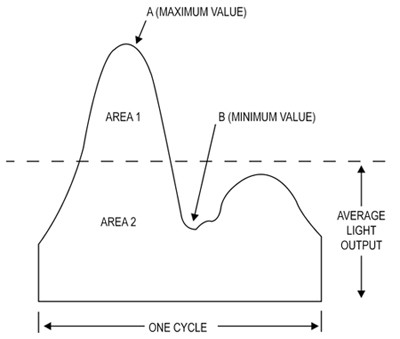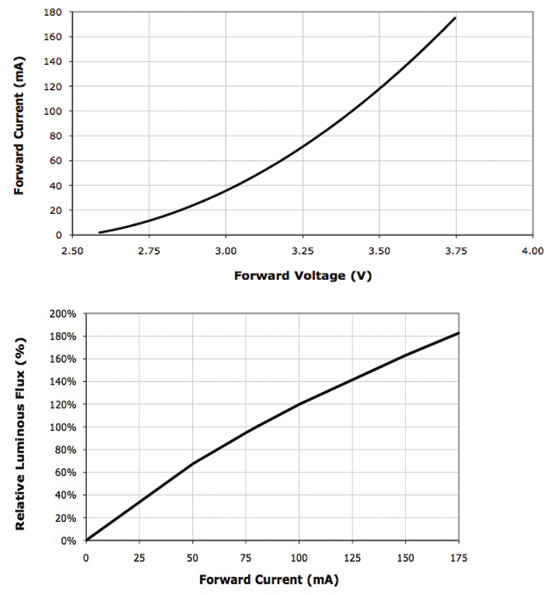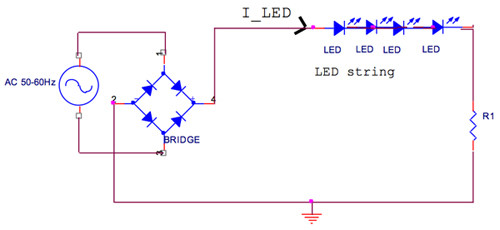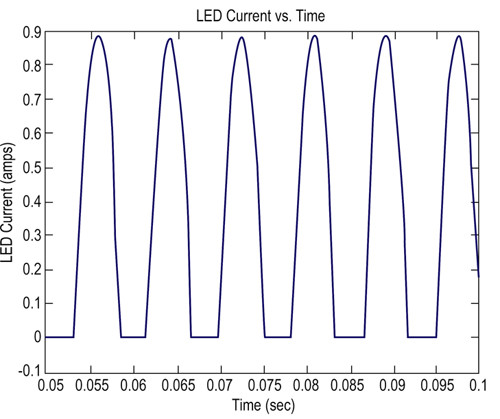Characterizing and Minimizing LED Flicker in Lighting Applications
17. Juli 2012
über
über

By Steven Keeping
Contributed By Electronic Products
2012-07-17
Although LED lights can be supplied with driver circuitry to allow them to be connected to the existing domestic AC power supply, there is a risk that flickering could occur as a result of voltage ripple at the supply’s output. Flickering occurs with most lighting, and some consumers complain that the effect makes them feel uncomfortable or even ill.
LED and luminaire manufacturers are keen to get to the root of the problem, because should solid-state lighting get a reputation for flickering – however undeserved – convincing consumers to move away from traditional lights will become more difficult.
This article investigates the cause of flickering, describes why it is a particular problem for LEDs, and explains how engineering administrative and standards-making bodies are trying to quantify the phenomenon for test houses and the LED, driver chip, and luminaire makers. The article will then describe some recent product introductions from major silicon vendors that claim to offer a cost-effective way of implementing flicker-free LED lighting.
The effect of flicker
According to studies about 1 in 4,000 people are highly susceptible to flashing lights cycling in the 3 to 70 Hz range. Such obvious flickering can trigger ailments as serious as epileptic seizures. Less well known is the fact that long-term exposure to higher frequency (unintentional) flickering (in the 70 to 160 Hz range) can also cause malaise, headaches, and visual impairment.
Unfortunately, unless a person is in natural daylight, they are likely to be exposed to this higher frequency flickering, because all mains-powered light sources, whether incandescent, halogen, fluorescent or LED, are subject to flickering. The source is the AC component of the power supply and the frequency of the flickering is typically either equal to the mains frequency (usually 50 or 60 Hz) or double the mains frequency.
Tests show that humans find it difficult to directly sense light flickering at these higher frequencies, but that seems to hardly matter. Scientists have conducted research that indicates the human retina is able to resolve light flickering at 100 to 150 Hz, even if the subject is not aware of it, leading to the conclusion that the brain may well be reacting.
The insidious effects of this so-called imperceptible flickering in the 100 to 150 Hz range are not just a function of frequency; physical and physiological factors also play a big part. For example, bright light is worse than dim, and the difference between “bright” and “dark” parts of the lighting pattern are important (a light that goes completely dark during the “off” part of the cycle is worse than one which only partially dims). Red light and alternating red and blue can be particularly troublesome, and the position of the light source on the retina is important, as light sensed by the center is worse than that falling on the periphery.
Some researchers even claim the retina can sense flickering up to 200 Hz, but tests have shown that above 160 Hz the health effects of flickering are negligible.¹
Defining flicker
Until recently, lighting engineers have been relatively unconcerned by the effects of imperceptible flicker. However, the tightening of health and safety rules, better research, and increasing complaints from staff working in offices illuminated by ubiquitous fluorescent tubes have led to calls for action.
But without a definition for flicker, who’s to say whether one light source is better than another? The Illuminating Engineering Society of North America (IESNA) has addressed this challenge and come up with a definition of “percent flicker” and “flicker index” in the ninth edition of The IESNA Lighting Handbook. Figure 1 shows how the metrics are defined.

Percent flicker is a relative measure of the cyclic variation in output of a light source (i.e., percent modulation). This is also sometimes referred to as the “modulation index.”
From the figure: Percent flicker = 100 x (A – B)/(A + B)
Flicker index is a “reliable relative measure of the cyclic variation in output of various sources at a given power frequency. It takes into account the waveform of the light output as well as its amplitude,” according to the handbook. The flicker index assumes values from 0 to 1.0, with 0 for steady light output. Higher values indicate an increased possibility of noticeable lamp flicker, as well as stroboscopic effect.
Again, from the figure: Flicker index = Area 1/Area 1 + Area 2
The problem with LEDs
The physical characteristics of LEDs determine that they must be powered in a different way to other light sources (see the TechZone article “Understanding the Cause of Fading in High-Brightness LEDs”).
LEDs are, as the name states, a form of diode. In normal operation, a constant forward voltage of sufficient magnitude (typically with the LED in series with a resistor) such that the device is operating in its conduction region, is applied. Forward voltages for commercial high brightness devices are typically in the 3 to 4.5 V range. The relationship between forward voltage (VF) and forward current (IF) is important because the current determines the relative luminous flux (essentially the brightness) of the LED.
The device manufacturer will recommend a tight operating range for an LED that is typically a compromise between brightness and efficacy.
Figures 2a and b illustrate the voltage vs. current and current vs. relative luminous flux for a Cree XLamp ML-B LED. Variation in the forward voltage will affect the forward current and hence the luminous flux.

Powering an LED chip from an AC source requires a regulator to step-down the 110 to 115 or 230 to 240 V, 50 or 60 Hz mains supply used by most countries to the modest voltage and current requirements of LEDs. Note that luminaires typically use six to eight LED chips per fixture, so the power requirement for each unit is higher than that for a single LED.
One basic form of LED driver comprises a full wave rectifier (Figure 3) connected to an LED string with a resistor in series to limit the current. This approach modulates the LEDs at twice the AC frequency (i.e., 100 to 120 Hz). Because the luminous intensity is proportional to the current, the LED flickers at this rate (Figure 4).


All light sources that ultimately derive their power from the AC mains are likely to flicker. But LEDs are particularly bad because the flicker index (or depth of modulation) is typically worse than conventional light sources.
This is because LEDs react particularly quickly to current variations. At 120 Hz, both the LED itself and its white-light-emitting phosphor have plenty of time to completely stop producing photons during the “off” part of the waveform. In contrast, conventional light sources, particularly incandescent and halogen types, have “inertia”. This means that even during the “off” part of the cycle, they still emit some photons.
Table 1 summarizes the percent flicker and flicker index of various light sources including LEDs driven from both DC and AC sources.² (The “Min,” “Max,” and “Ave” columns summarize the relative intensity of each source.)
As noted above, in addition to the frequency, the flicker index has a significant effect on how the light makes people feel. Higher flicker index tends to be more noticeable and hence is potentially more detrimental.
| Max | Min | Ave | % Flicker | Flicker Index | |
| Incandescent | 12.180 | 10.745 | 11.460 | 6.2594 | 0.0194 |
| 100 W MH | 9.1472 | 3.2066 | 6.5147 | 48.088 | 0.1398 |
| T12 Magnetic | 9.6281 | 4.6256 | 7.1565 | 35.096 | 0.0897 |
| T5HO Elec | 10.52 | 9.960 | 10.20 | 2.734 | 0.0036 |
| LED at DC | 43.4 | 41.0 | 42.2 | 2.84 | 0.0037 |
| LED w/ Flicker | 15.996 | 0.0555 | 6.3026 | 99.309 | 0.4498 |
Table 1: Summary of percent flicker and flicker index for light sources. Higher flicker index is more noticeable to the human eye.
Improved LED drivers
Most contemporary LED drivers are a little more sophisticated than the simple example given in Figure 3, with high-frequency switching power supplies being a popular choice because of their efficiency. Input and output filtering utilized by the switching supplies dramatically reduces the AC component of the mains supply at the output, but some ripple is unavoidable. Some units are worse than others, so the engineer is advised to choose their LED driver carefully.
While switching LED power supplies help reduce the flicker index by attenuating the AC component of their output, the frequency of flickering, at twice the mains frequency, is unaffected and remains right in the range that has been identified by researchers as a problem for humans.
The influential U.S. Environmental Protection Agency (EPA) has attempted to address the problem by recommending that the operational frequency for LEDs be raised to 150 Hz. The organization’s ENERGY STAR specifications – to which makers must adhere is they want to qualify for commercially advantageous ENERGY STAR certification - include one aimed at flicker.
In 2009, the specification referring to flicker was changed to stipulate a minimum LED operating frequency of 150 Hz, up from 120 Hz in the previous version of the spec. LED and semiconductor manufacturers were less than impressed because changing their products to suit the new frequency would have been very expensive.
In a letter to interested parties dated March 2010,³ the EPA relented and changed the specification back to the original 120 Hz, where it remains to this day.
That said, there are many LED drivers on the market that connect directly to a mains supply yet claim to produce “flicker-free” power. Cirrus Logic, for example, has recently released its CS161x LED Driver family (CS1610-FSZ, CS1611-FSZ). The chips are suitable for use with 100 to 120 VAC and 220 to 240 VAC line voltages and boast the added advantage of maintaining the flicker-free performance even when used with legacy dimming switches (which often introduce complications for LED drivers that compromise flicker index).
CUI Inc. also offers a constant current driver that offers flicker-free performance at full brightness and when used with traditional dimming switches, called the V-Infinity VLED15 (Figure 5). The module is available in two versions, one for 115 VAC inputs and the other for 230 VAC inputs.

Another option is ROHM Semiconductor’s BP5843A. This is an 11-pin SIP module that can be used to power several high brightness LEDs in serial or parallel from a 113 to 170 VAC supply. The module features a low peak-to-peak output voltage ripple that helps ensure flicker-free LED power.
In summary
Lighting engineers designing LED luminaires can point to many advantages for their light sources, such as efficacy, longevity, and robustness. However, they do need to be aware of the potential adverse reaction to their products that could be prompted if the consumer feels uncomfortable under solid-state lights.
Although the flicker may be imperceptible, it could still be a problem. For example, workers in offices illuminated by flickering fluorescent tubes have been quick to point to “sick building syndrome” as a reason for higher-than-average absence rates. There is no direct evidence that flicker causes the malaise, but recent research suggests there is a good chance it is one of the causes.
Accordingly, designing LED lighting with flicker reduction in mind is a good idea. Choose good quality high frequency switching LED drivers, as these will minimize the AC component in the voltage and current ripples at the output – which in turn will limit the modulation depth of the LEDs’ flicker. And, although further research is needed to confirm the suggestion, it is also a good idea to keep a look out for LED drivers that convert the AC component in the output ripple to 150 Hz or higher, because early indication are that at this frequency, any flicker has a negligible effect on health.
References:
- “A Review of the Literature on Light Flicker: Ergonomics, Biological Attributes, Potential Health Effects, and Methods in Which Some LED Lighting May Introduce Flicker,” IEEE Standard P1789, February 2010.
- “The Evaluation of Flicker in LED Luminaires,” Michael Grather, President, Luminaire Testing Laboratory, Inc.
- Open letter from Alex Baker, Lighting Program Manager, ENERGY STAR, dated March 22, 2010.
Disclaimer: The opinions, beliefs, and viewpoints expressed by the various authors and/or forum participants on this website do not necessarily reflect the opinions, beliefs, and viewpoints of Digi-Key Corporation or official policies of Digi-Key Corporation.
Mehr anzeigen
Weniger anzeigen


Diskussion (0 Kommentare)